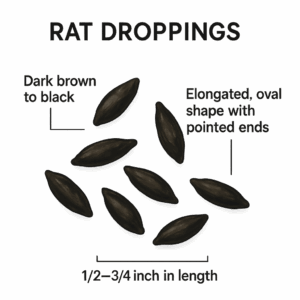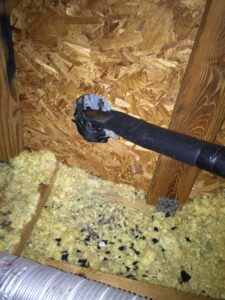Have you discovered mysterious droppings in your house? Rat droppings are one of the most obvious signs of a rat infestation.
If they are small, dark pellets, the feces came from a rodent. The droppings can help identify the rodent in your house, which determines what rodent removal technique and solution to apply.
This guide will help you identify rat droppings in your home so you can take the appropriate steps to address the issue.
Why Is identifying rat droppings important
Recognizing rodent droppings in your house is essential for multiple reasons. By identifying rat droppings inside the house, it will help you create a rat control solution.
- Health Risks: Animal droppings can harbor harmful bacteria, parasites, and pathogens that pose serious health risks. Diseases such as Hantavirus, salmonella, and leptospirosis can be transmitted through droppings. Identifying the type of droppings helps you assess potential health risks and take necessary precautions.
- Property Damage: Ignoring animal droppings can lead to significant property damage. Rat droppings have high levels or uric acid which can degrade wood, drywall, and insulation.
- Odor Problems: Rat poop can create a persistent and foul odor in your home. The smell can permeate walls, furniture, and fabrics, requiring costly cleaning or replacement.
- Staining: Rat feces can leave unsightly stains on walls, ceilings, or floors. These stains are often difficult to remove and may require specialized cleaning.
What do Rat droppings look like
Typically dark brown or black, rat droppings are tapered and measure about 1/2 to 3/4 inch long, resembling grains of rice with blunt ends. They are usually found in concentrated areas, indicating high activity. Immediate action is necessary if you find these droppings to prevent an infestation.

Rat Droppings in Attic insulation

Roof rats in Jacksonville most often nest in the attic. You should not ignore rat droppings in your attic insulation. Even if you don’t see the rat, there is evidence that rats were there, and they can come back.
Seeing just a few rat droppings in your insulation might be tempting to ignore especially if they appear old. Fresh droppings are shinier and darker. Old droppings appear chalky and dry, but rat feces start to look old after 48-72 hours.
Rat vs mouse vs squirrel droppings
Mice and squirrels are the other two most common rodents that get into attics and walls in Jacksonville. All rodents in the house create similar problems. They damage insulation and physical structures, and their droppings contaminate and corrode.
Mice Droppings
Smaller than rat droppings, mouse droppings are about 1/4 inch long with pointed ends and are often scattered. If you find small droppings spread around your house, you likely have a mouse problem.
Squirrel Droppings
Larger than rat and mouse droppings, squirrel droppings measure about 3/8 to 1/2 inch long and are cylindrical. They are commonly found in attics, crawl spaces, or near entry points. Addressing a squirrel issue promptly is important to prevent further property damage.
Health Risks from rat droppings
Rat droppings can spread diseases to you and your family. Here are some diseases that can be transmitted through droppings:
Hantavirus: Often found in deer mouse droppings, this potentially life-threatening virus can lead to Hantavirus Pulmonary Syndrome when airborne particles from contaminated droppings are inhaled.
Salmonellosis: Caused by the bacterium Salmonella, this infection can occur from ingesting food or water contaminated with animal droppings, leading to symptoms like diarrhea, fever, and abdominal pain.
Leptospirosis: Transmitted through contact with animal urine, including droppings, this bacterial disease can cause mild flu-like symptoms to severe complications affecting organs like the liver and kidneys.
When cleaning up animal droppings, take these precautions to minimize infection risk:
Wear protective clothing, including gloves, a mask, and goggles, to prevent direct contact and inhalation of harmful particles.
Avoid sweeping or vacuuming droppings, as this can release particles into the air. Instead, dampen the area with a disinfectant solution and use disposable materials to carefully pick up and dispose of the droppings.
Wash your hands thoroughly with soap and water after handling droppings or contaminated materials.
Proper disposal of contaminated materials is crucial to prevent disease spread. Seal the droppings and cleaning materials in a plastic bag and dispose of them in an outdoor trash can with a tight-fitting lid. Clean and disinfect any surfaces that may have been in contact with the droppings.
Preventing rat droppings in the house
Preventing rodents from entering your house is essential to avoid potential damage or health hazards. Here are a few effective measures you can take:
- Sealing Entry Points: Inspect your house for cracks, holes, or gaps that can serve as entry points for animals. Seal these openings using caulk, mesh wire, or hardware cloth. Pay attention to areas around windows, doors, vents, and utility pipes.
- Removing Attractants: Animals are often drawn to food sources and shelter. Keep your property clean and free from attractants like uncovered garbage cans, fallen fruits, or bird feeders. Store pet food indoors and secure compost bins to deter wildlife.
- Maintaining Cleanliness: Regularly clean your house, especially areas prone to animal infestations like attics, basements, and crawl spaces. Remove any droppings, nests, or debris left by animals. This helps identify potential issues and discourages animals from returning.
Implementing these preventive measures can significantly reduce the risk of animals entering your house. If you suspect an animal infestation or need help identifying animal droppings, consult a professional rat removal in Jacksonville from Trutech Wildlife Service. They have the expertise and experience to handle wildlife issues effectively, ensuring the safety of your home and family.
